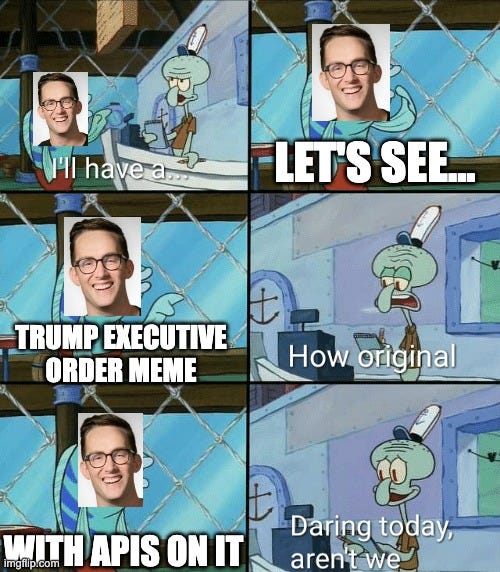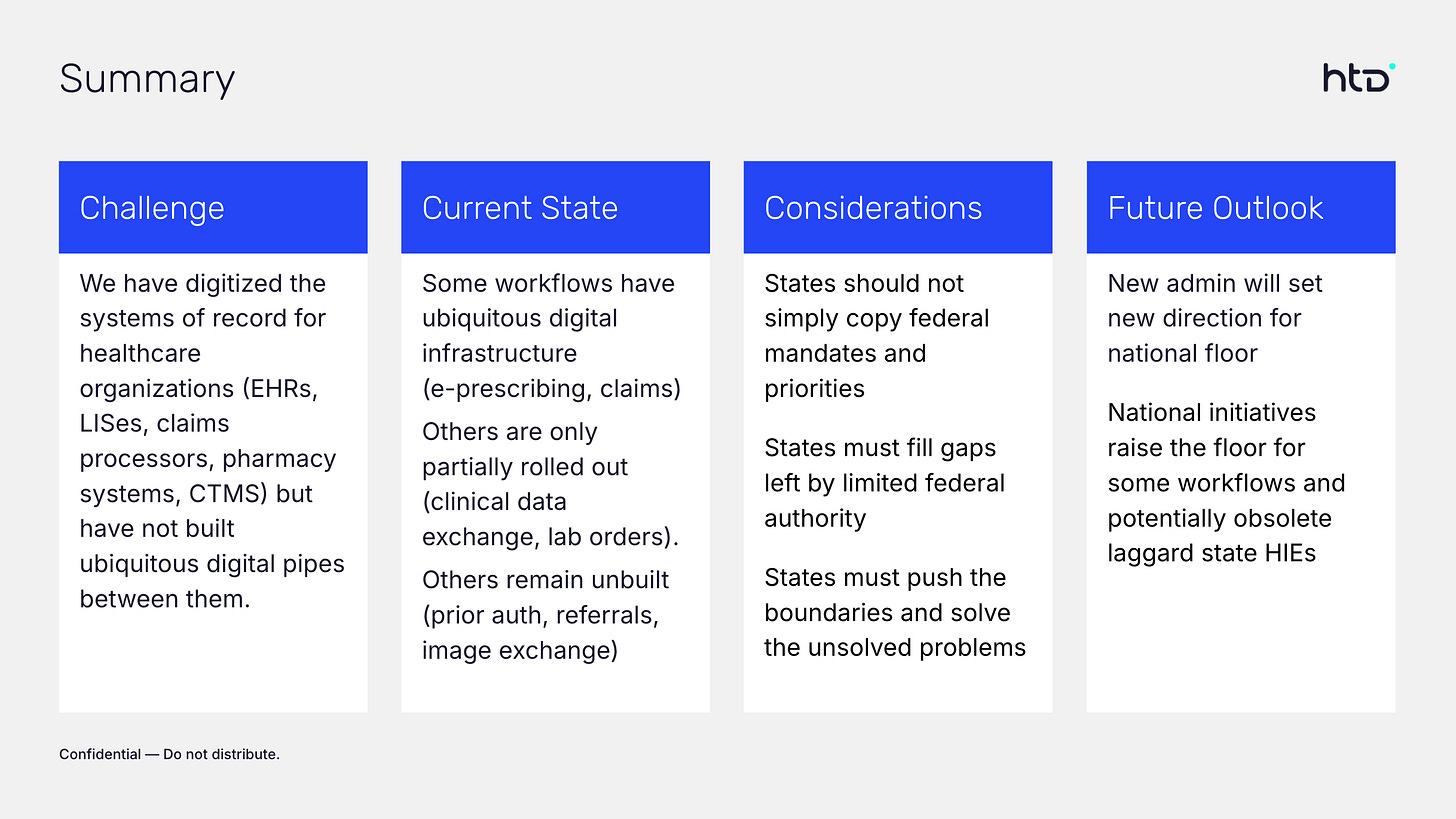Monthly Review: Executive Order Edition
Stargate, court case updates, administration transitions, and the effect of the principal agent problem
ViVE is quickly approaching! Whether you pronounce it as if it rhymes with “jive”, you’re the oddball who think its phonetically similar to “sieve”, or you add a Spanish flair to it make it more fun, I and HTD would be excited to see and meet up with you there to talk about health information exchange, EHR integration, digital referral strategy, or really anything related to data movement in healthcare.
Make sure to reach out if you’re game!
It’s late January. It’s a New Year. The indomitable, unceasing drumbeat of time plays on, driving us forward whether we like it or not. We stand awash in a torrent of executive orders, some benign, some potentially violating federal and constitutional law. The slurry of political action is so thick and opaque that it’s quite overwhelming. Some (Buckeyes fans) at least can bask in the afterglow of a new era of college football, while others (me, any other ND alum, and most of the nation) reflect upon yet another season that came up just short. As an Eagles fan, it would be somewhat poetic for the city of Washington to provide me more pain and anxiety this month on another axis by completing the double whammy and taking down my hometown Eagles this Sunday. Thoughts and prayers for Health API Guy.
By the authority vested in me as the Health API Guy and the laws of the Healthcare Interoperability, it is hereby ordered:
Section 1. Purpose. To provide Americans and our international colleagues with a monthly review so as to inform them of the daily and weekly chatter that occurs on social media networks concerning healthcare interoperability news, regulation, and policy.
Regulatory:
ASTP Leadership Transition: The search for the next head of the artist formerly known as the ONC will likely follow historical patterns rather than return to previous leadership. Despite speculation about Donald Rucker's potential return, the role has historically favored first-time appointees with MD credentials and public sector experience. While Micky Tripathi broke precedent as the first non-MD leader, his successor will likely return to the traditional mold of a physician with both government and industry experience.
Price Transparency’s Next Phase: Price transparency initiatives that gained momentum under Trump's first term and accelerated under Biden appear poised for renewed focus in Trump 2.0. While the immediate impact may consolidate pricing distributions, the industry faces new challenges similar to property management, where transparency tools have faced antitrust scrutiny for potentially enabling price collusion.
Court cases:
Particle v. Epic: Particle Health filed its response to Epic's motion to dismiss. While they make strong arguments about market definition based on customer type, their response struggles to explain why apparent competitors like Datavant should be excluded and how their payer product differs from their non-payer offerings, with the same products (Signal and Snapshot) marketed to both markets.
Cognizant v. Infosys: A wild payer software platform antitrust case has appeared! In this case, it’s in regards to Core Administrative Processing Systems offered by the tech services firm Cognizant, which acquired both QXNT and Trizetto a decade ago and has a majority of the market. Infosys alleges it used its monopoly power to foreclose the competition of its more modern equivalent, Helix.
Palo Verde v. Altera: A critical case highlighting the vulnerability of rural healthcare providers concluded in September 2024 via sealed settlement. Palo Verde Healthcare District - the only hospital within 90 minutes serving a vast desert region including 4,000 prison inmates - alleged Altera engaged in information blocking by threatening to cut off system access unless they paid $1.3M. The dispute, which required multiple emergency court interventions to prevent system shutdown, demonstrates how information blocking regulations now provide additional protections in vendor disputes compared to similar pre-2020 cases like Fung-Schwartz v. Cerner.
Intus Care v. RTZ Systems: A precedent-setting case testing the scope of information blocking regulations beyond certified EHRs. IntusCare alleges RTZ Systems (makers of PaceCare) is a health information network due to its lab and e-prescription interfaces, making it subject to information blocking rules despite not being a certified EHR. While superficially similar to Real Time Medical Systems v. PointClickCare, this case could dramatically expand the definition of information blocking actors beyond traditional HIEs to any software facilitating health data exchange. The case entered mediation in September 2024, potentially precluding a definitive ruling on this novel interpretation.
Information Blocking Litigation Precedent: Initial court decisions in RTMS v. PointClickCare and IntusCare v. RTZ establish that, while the Cures Act lacks a private right of action, EHRs remain vulnerable to litigation through alternative legal theories. Courts have ruled that information blocking can serve as an "independently wrongful act" for tortious interference claims or as evidence of unfair competition, even when the underlying regulation can only be enforced administratively. If this stands, this creates a viable pathway for future private litigation against EHRs over information blocking, though the EHR Association's amicus brief in the PCC appeal seeks to overturn this interpretation.
EHRs:
Epic rebranding: America’s largest EHR has changed the name of their Health Grid offerings (including Payer Platform) to "Save a Life" Grid. This move signals a potential repositioning of their network offerings to payers, labs, and clinical trials, though the strategic rationale is pretty baffling and hard to discern. The antitrust scrutiny on Payer Platform may be the motivating factor, but the new name feels heavy handed if that’s the case.
Oracle and Stargate: Oracle joined a high-profile AI initiative alongside Softbank and OpenAI, with Larry Ellison emphasizing healthcare applications as the leading use case. While the announcement garnered attention for promising AI-powered clinical decision support across institutions, the core functionality mirrors Epic's existing Cosmos platform, which already provides similar capabilities across 293 million patients and 15.1 billion encounters. The initiative may help Oracle customers catch up to Epic's capabilities in deidentified data aggregation and treatment insights, but doesn't fundamentally advance interoperability challenges as is.
Industry Analysis:
Principal Agent Problem: Unlike consumer software where buyer and user align, enterprise healthcare technology must serve two masters: executives who control purchasing and clinicians who use the tools daily. This inherent tension forces vendors to either compromise user experience for buyer requirements or risk failed adoption despite happy users - a challenge fundamental to enterprise sales rather than unique to EHRs.
Principal Agent Problem in Action: Alex LeBrun (CEO at Nabla, one of the top AI scribe companies) posted about how a small practice reached out to him to know which EHR he should choose to best integrate with the scribe product. While it’s cool to see the inversion of buying behavior, it’s a clear example of how the principal agent problem disappears at the SMB side of the market, as the principal and agent converge and the priorities of the end user match the buyer.
Cross-industry Comparisons:
Internet erosion of protected powers: The Internet has consistently shown the ability to devolve traditional gatekeepers’ roles and responsibilities to consumers. We're seeing early signs of traditional healthcare gatekeeper roles evolving, similar to how internet transformed banking and travel planning. While patient portals and direct scheduling represent initial steps, the industry grapples with balancing access and appropriate clinical oversight.
Provider Technology Discovery: Tools like StackShare allow tech companies to share the technology they use publicly, a pattern I wish provider organizations would follow.
Tech-enabled Care and the Opco/Propco Parallels:
is an excellent Substack focused on property management. While not explicitly technology-focused, often covers proptech software and startups, which is excellent fodder to contrast to digital health. The Opco/Propco model he describes is eerily similar to the PC/MSO model that many tech-enabled care organizations use, with accordingly similar tensions between tech and operations.

Other News:
An Epic Tale: The Startup Odyssey: If you’re reading this, you’re subscribed to this Substack, so not sure how you would have missed it, but the next article in the ongoing Epic series came out last week. It’s a bit of a beast at 9000 words but it is ideally an evergreen resource on Epic’s developer programs and marketplaces. They are a constant source of confusion and misinformation for startups and big companies alike, so it’s one of the most common things I’m asked about. And don’t worry - more to come in this series. With every rise comes the fall.
Ex-Epic Slack Community: The Epic Alumni Slack Community marked its first year with impressive reach across 626 participants in 41 states and 11 countries. Beyond traditional networking, the community has evolved into a vibrant professional resource, facilitating job placements, technical problem-solving, regulatory discussions, and even emergency support for members facing career challenges. I’m excited by the growth and the fun discussions it’s spurred, so make sure to join if interested.
External Media:
Chat with Bryan Vartabedian, MD: Discussed the principal-agent problem and how it manifests in technology buying and decision making for healthcare organizations
Elion Briefing Executive Insights with Bobby Guelich: Shared key health tech priorities for the year ahead, focusing on the major court cases reshaping health data access rights and the new administration’s impact on health tech regulation - particularly around ASTP leadership and TEFCA's future.
Designing for Health with Craig Joseph, MD: Joined Dr. Craig Joseph to discuss healthcare interoperability, examining how diverse workflows make healthcare data exchange more complex than banking transactions, current industry legal battles, and AI's emerging role as a "copilot" rather than replacement for interoperability work.
Events:
State of Reform: Washington (Seattle, Jan 9): I was impressed by the State of Reform conference. Before being invited to speak on the panel (Washington's Health Data Exchange Infrastructure), I hadn’t tracked it before, but it was a solid mix of government officials, providers, and digital health, with clear payer sponsorship and attendance. No recording yet, but here’s my one slide about states’ role in health infrastructure:
ViVE (Nashville, Feb 16-19): Not speaking but certainly participating. The hunt for karaoke starts now.
HIMSS (Vegas, March 3-6): As mentioned last month, I’m keynoting the HIE Forum as part of HIMSS. Do I know all the secrets to interoperability in 2025? How many pop culture references are possible in a 30-minute keynote? Are verbal memes a thing? Rise and shine to find out all this and more.






